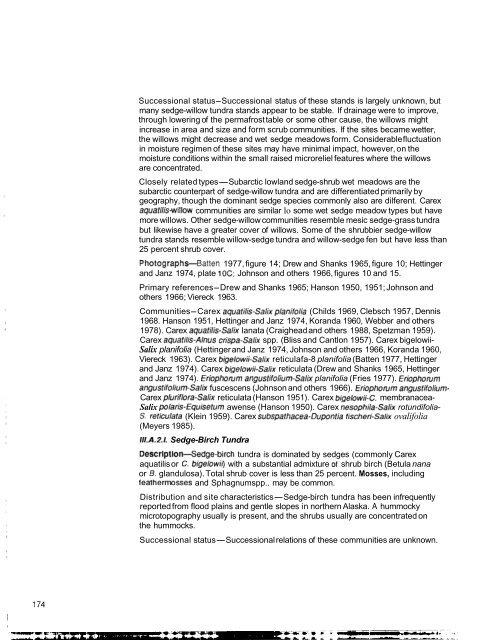The Alaska Vegetation Classification - Alaska Geobotany Center ...
The Alaska Vegetation Classification - Alaska Geobotany Center ...
The Alaska Vegetation Classification - Alaska Geobotany Center ...
You also want an ePaper? Increase the reach of your titles
YUMPU automatically turns print PDFs into web optimized ePapers that Google loves.
Successional status-Successional status of these stands is largely unknown, butmany sedge-willow tundra stands appear to be stable. If drainage were to improve,through lowering of the permafrost table or some other cause, the willows mightincrease in area and size and form scrub communities. If the sites became wetter,the willows might decrease and wet sedge meadows form. Considerable fluctuationin moisture regimen of these sites may have minimal impact, however, on themoisture conditions within the small raised microreliel features where the willowsare concentrated.Closely related types-Subarctic lowland sedge-shrub wet meadows are thesubarctic counterpart of sedge-willow tundra and are differentiated primarily bygeography, though the dominant sedge species commonly also are dilferent. Carexaquatiliswillow communities are similar lo some wet sedge meadow types but havemore willows. Other sedge-willow communities resemble mesic sedge-grass tundrabut likewise have a greater cover of willows. Some of the shrubbier sedge-willowtundra stands resemble willow-sedge tundra and willow-sedge fen but have less than25 percent shrub cover.PhotographHatten 1977, figure 14; Drew and Shanks 1965, figure 10; Hettingerand Janz 1974, plate 1OC; Johnson and others 1966, figures 10 and 15.Primary references-Drew and Shanks 1965; Hanson 1950, 1951; Johnson andothers 1966; Viereck 1963.Communities-Carex aquatilis-Salixplanifolia (Childs 1969, Clebsch 1957, Dennis1968. Hanson 1951, Hettinger and Janz 1974, Koranda 1960, Webber and others1978). Carex aquatilis-Salix lanata (Craighead and others 1988, Spetzman 1959).Carex aquafilis-Ahus crispa-Salix spp. (Bliss and Cantlon 1957). Carex bigelowii-Salix planifolia (Hettinger and Janz 1974, Johnson and others 1966, Koranda 1960,Viereck 1963). Carex bigelowii-Salix reticulafa-8 planifolia (Batten 1977, Hettingerand Janz 1974). Carex bigelowii-Salix reticulata (Drew and Shanks 1965, Hettingerand Janz 1974). €riophorum angustifolium-Salk planifolia (Fries 1977). friophorumangustifolium-Salix fuscescens (Johnson and others 1966). Erio~horumangusfifolium-Carex pluriflora-Salk reticulata (Hanson 1951). Carex bigelowii-C. membranacea-Salix polaris-€quisetum awense (Hanson 1950). Carex nesophila-Salix rotundifolia-S. reficulata (Klein 1959). Carex subspathacea-~upontia fischeri-Salix ovalifolia(Meyers 1985).lll.A.2.i. Sedge-Birch TundraDescription-Sedge-birch tundra is dominated by sedges (commonly Carexaquatilis or C. bigelowi!) with a substantial admixture of shrub birch (Betula nanaor B. glandulosa). Total shrub cover is less than 25 percent. Mosses, includingfeathermsses and Sphagnumspp.. may be common.Distribution and site characteristics-Sedge-birch tundra has been infrequentlyreported from flood plains and gentle slopes in northern <strong>Alaska</strong>. A hummockymicrotopography usually is present, and the shrubs usually are concentrated onthe hummocks.Successional status-Successional relations of these communities are unknown.
















